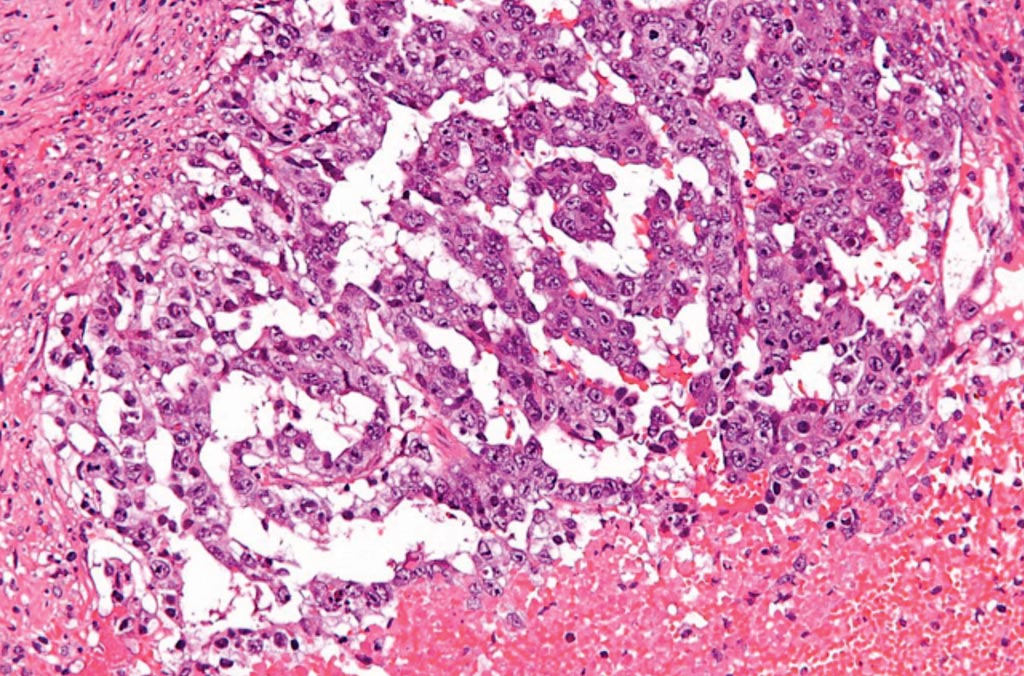Integrated Analyses Offer Molecular Insights to Tumor Subtypes
By LabMedica International staff writers
Posted on 20 Jul 2018
The most common malignancy of young adult males of European descent are testicular germ cell tumors (TGCTs) of the type derived from germ cell neoplasia in situ (GCNIS). There are two major histologic types: pure classic seminoma and nonseminomatous germ cell tumors (NSGCTs).Posted on 20 Jul 2018
Seminoma often has more indolent behavior, while NSGCT tends to occur at younger ages and confer higher mortality. TGCTs are now highly treatable, and overall relative survival of men with TGCTs exceeds 95%; however, survivors can experience devastating late effects of treatment.

Image: A histopathology of mixed germ cell tumor of the testes demonstrating the high-grade cytology, typical for embryonal carcinoma (Photo courtesy of Nephron).
An extensive team of scientists collaborating with those at University of North Carolina at Chapel Hill (Chapel Hill, NC, USA) studied 137 primary testicular germ cell tumors (TGCTs) using high-dimensional assays of genomic, epigenomic, transcriptomic, and proteomic features. The median age of diagnosis was 31 years, with a range of 14 to 67. Patient tumor histology was classified according to a consensus of expert pathologists. Molecular and genomic data were collected using reverse phase protein arrays (RPPAs), whole-exome DNA sequencing, RNA-seq, miRNA sequencing, DNA methylation arrays, and SNP arrays for copy number analysis.
The team reported that as expected, the 72 seminomas in this set clustered apart from the non-seminomatous tumors, based on these molecular data. They saw relatively limited mutation frequencies across most of the histological subtypes. Just three genes, KIT, KRAS, and NRAS, were significantly mutated in the TGCTs, and those recurrent mutations were limited to the seminoma subtype. Within seminomas, DNA methylation and immune infiltration differences also tended to coincide with the presence or absence of KIT gene mutations. Still other mutation frequency, ploidy, DNA methylation, and/or miRNA expression shifts corresponded with the remaining non-seminomatous subtypes.
In teratoma and yolk sac tumors, the group saw enhanced expression of a miRNA called miR-375 that is typically found at low levels in blood samples from healthy individuals. On the other hand, the embyronal carcinomas had higher-than-usual expression of miR-19 and other miRNAs, they noted, and were marked by DNA methylation at non-canonical cytosine sites.
The authors concluded the new TGCT molecular profiles afforded a more complete view of previously articulated hypotheses, provide additional insights into mechanisms of TGCT tumorigenesis, and identify possible new approaches to the treatment of TGCTs. Katherine Hoadley, PhD, is an assistant professor in Cancer Genetics and senior author of the study, said, “Integration of tumor characteristics and genomic and epigenomics data revealed distinctive molecular landscapes of TGCT histologic types, and identified previously unappreciated diversity within seminomas.” The study was published on June 12, 2018, in the journal Cell Reports.
Related Links:
University of North Carolina at Chapel Hill














